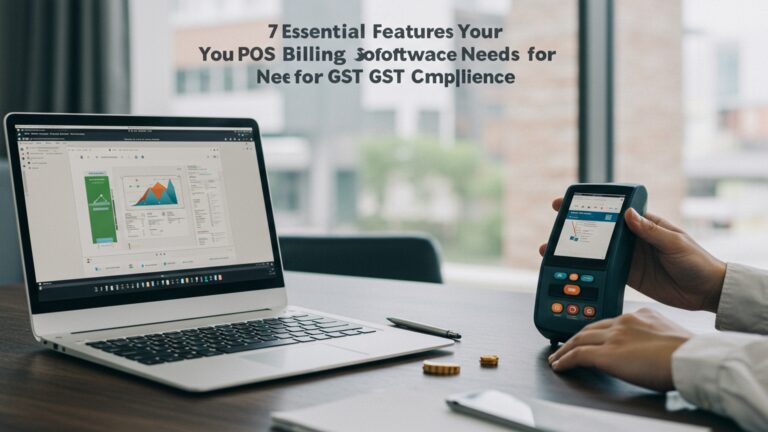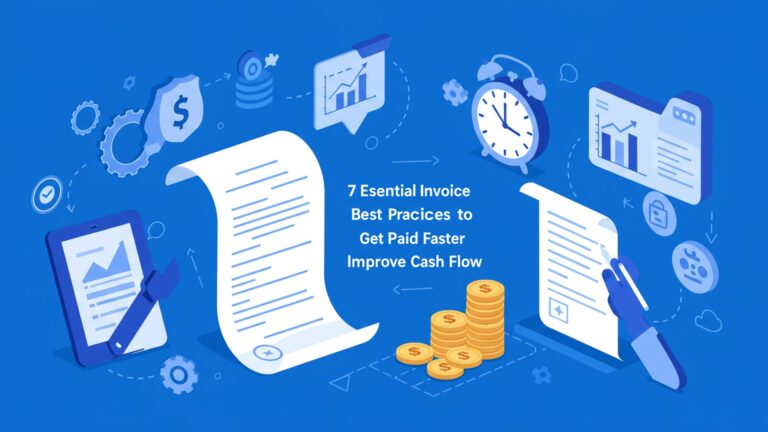Learn 7 Crucial GST Invoicing Tips to Avoid Common Mistakes
Inaccurate GST invoicing remains a critical vulnerability for businesses, extending beyond mere administrative oversight to trigger significant Input Tax Credit (ITC) blockages and potential penalties under Section 122 for non-compliance. With the recent expansion of e-invoicing thresholds and increased digital scrutiny, mastering essential GST invoicing tips is no longer optional but a fundamental operational safeguard. Errors like incorrect HSN/SAC codes or misapplied tax rates can instantly flag transactions, disrupting crucial cash flow and inviting stringent audits. Proactive precision in your invoicing practices ensures not only seamless regulatory adherence but also fortifies your financial stability within an increasingly complex digital tax ecosystem.

1. Master the Fundamentals of GST and Invoice Types
Before diving into the specifics of creating compliant invoices, it’s crucial to have a solid grasp of what the Goods and Services Tax (GST) entails and the various types of invoices mandated under this regime. GST is a comprehensive, multi-stage, destination-based tax levied on every value addition. It has revolutionized India’s indirect tax structure, making proper invoicing a cornerstone of compliance.
Understanding these fundamentals is the first of many crucial GST invoicing tips. An invoice isn’t just a bill; it’s a legal document that evidences a supply of goods or services, details the transaction. serves as a key record for both the supplier and the recipient for input tax credit (ITC) claims.
- Tax Invoice: This is the most common type, issued when a registered person supplies taxable goods or services to another registered person or an unregistered person. It must clearly show the GST charged.
- Bill of Supply: Issued by a registered person when supplying exempt goods or services, or when opting for the composition scheme. No GST is charged or shown on these bills.
- Revised Invoice: Issued when there’s a change in the GST rate, place of supply, or other details after an original invoice has been issued, often due to a change in registration status.
- Debit Note: Issued by a supplier to increase the value of an already issued tax invoice (e. g. , due to price revision or goods returned by buyer that were initially over-invoiced).
- Credit Note: Issued by a supplier to decrease the value of an already issued tax invoice (e. g. , due to goods returned, post-sale discounts, or a decrease in taxable value).
Mistake to Avoid: Using the wrong type of document. For instance, issuing a Bill of Supply instead of a Tax Invoice for taxable goods can lead to penalties and denial of ITC for the recipient.
2. Ensure Impeccable GSTIN and Legal Entity Details
Accuracy in identifying both the supplier and the recipient is non-negotiable for GST compliance. The Goods and Services Tax Identification Number (GSTIN) is a unique 15-digit number assigned to every registered taxpayer. It’s vital for tracking transactions and claiming Input Tax Credit (ITC).
When preparing your invoices, one of the most critical GST invoicing tips is to meticulously verify the GSTIN and other legal details. Incorrect or missing insights can invalidate the invoice for ITC claims and lead to compliance issues.
- Supplier’s Details: Your own legal name, address. GSTIN must be prominently displayed. Ensure these match your GST registration certificate exactly.
- Recipient’s Details: If the recipient is a registered business, their legal name, address. GSTIN are mandatory. Always cross-verify the recipient’s GSTIN using the official GST portal to prevent errors. For unregistered recipients, their name and address are sufficient. if the value of taxable supply is above a certain threshold (currently INR 50,000 for inter-state supplies), the recipient’s name and address, along with the address of delivery, are required.
Example of a GSTIN format:
27AAAAA0000A1Z5
- The first two digits represent the State Code.
- The next ten digits are the Permanent Account Number (PAN) of the taxpayer.
- The thirteenth digit denotes the number of registrations a legal entity has within a state.
- The fourteenth digit is ‘Z’ by default.
- The last digit is a check sum digit.
Mistake to Avoid: A common error is entering an incorrect GSTIN for the recipient, either due to a typo or using an old/inactive number. This directly impacts the recipient’s ability to claim ITC, leading to disputes and potential penalties for the supplier.
3. Accurately Apply HSN or SAC Codes
The Harmonized System of Nomenclature (HSN) for goods and Services Accounting Code (SAC) for services are internationally recognized classification systems. Under GST, these codes are crucial for classifying goods and services, ensuring uniformity in taxation. streamlining data analysis.
Including the correct HSN or SAC codes is among the most overlooked yet vital GST invoicing tips. The number of digits required for HSN/SAC codes on an invoice depends on your aggregate annual turnover:
- For Businesses with Turnover up to INR 5 Crores: 4-digit HSN/SAC code is generally required.
- For Businesses with Turnover above INR 5 Crores: 6-digit HSN/SAC code is mandatory.
It’s crucial to research and identify the precise HSN/SAC code for each item or service you supply. The official GST portal and various government publications provide comprehensive lists and search functionalities.
Example: If you sell ‘Digital Cameras’, you would look for its specific HSN code, which might be
8525. 80
. For ‘Web Design Services’, the SAC code might be
998341
.
Mistake to Avoid: Using a generic HSN/SAC code when a specific one exists, or simply omitting it, can lead to discrepancies during audits and could result in penalties. Always ensure the codes accurately reflect the goods or services supplied.
4. Ensure Precise Tax Calculation and Rates
One of the most frequent areas of error in GST invoicing is incorrect tax calculation. The GST regime operates with various tax rates (0%, 5%, 12%, 18%, 28%) and different tax components depending on the nature of the supply.
Mastering tax calculation and applying the correct rates is a fundamental aspect of effective GST invoicing tips. Errors here can lead to either underpayment (resulting in interest and penalties) or overpayment (leading to loss of revenue or difficulties in refunds).
- Taxable Value: This is the value on which GST is calculated. It generally includes the price charged for the supply, plus any duties, taxes, fees. charges levied under any law (other than GST), interest, late fee or penalty for delayed payment. subsidies directly linked to the price (excluding government subsidies).
- GST Components:
- CGST (Central Goods and Services Tax): Levied by the Central Government on intra-state (within the same state) supplies.
- SGST (State Goods and Services Tax): Levied by the State Government on intra-state supplies. CGST and SGST are equally divided.
- IGST (Integrated Goods and Services Tax): Levied by the Central Government on inter-state (between different states) supplies and imports/exports. IGST is the sum of CGST and SGST.
When calculating, always apply the correct rate to the taxable value for each item. The invoice should clearly segregate the taxable value, the rate of tax. the amount of tax charged for CGST, SGST, or IGST.
Example: If you sell goods worth INR 10,000 within the same state with a GST rate of 18%:
- Taxable Value: INR 10,000
- CGST @ 9%: INR 900
- SGST @ 9%: INR 900
- Total Invoice Value: INR 11,800
Mistake to Avoid: Applying an incorrect GST rate (e. g. , using 12% instead of 18%), miscalculating CGST/SGST split, or failing to apply IGST for inter-state supplies. This not only impacts your own compliance but also the recipient’s ITC claim.
5. Implement Proper Invoice Numbering and Dating
Invoice numbering and dating might seem straightforward. they are critical for maintaining a clear audit trail and ensuring compliance. Every GST invoice must have a unique, sequential invoice number and an accurate date of issue.
Following a robust system for numbering and dating is one of the foundational GST invoicing tips for seamless operations and easy reconciliation.
- Unique & Sequential Numbering: Each financial year, your invoices must start with a fresh, continuous serial number. The numbering should be unique for each document type (e. g. , Tax Invoice, Credit Note). For instance,
FY23-24/001,
FY23-24/002. so on. There should be no gaps or duplicates in the sequence.
- Date of Issue: The date on the invoice must accurately reflect when the supply was made or when the invoice was generated, as per the ‘time of supply’ rules. This date is crucial for determining the tax period in which the transaction needs to be reported.
The GST rules specify that the invoice number should be a consecutive serial number, in one or more series, containing alphabets or numerals or special characters like hyphen or dash and slash symbol. unique for a financial year.
Mistake to Avoid: Duplicate invoice numbers or non-sequential numbering can create significant reconciliation challenges, lead to audit discrepancies. potentially attract penalties. Backdating or future-dating invoices can also be considered a serious offense, disrupting the ‘time of supply’ rules and tax period reporting.
6. Include All Mandatory Fields on the Invoice
The GST law prescribes specific data that must be present on every tax invoice to make it valid. Missing even one mandatory field can render an invoice non-compliant, leading to issues for both the supplier and the recipient.
Ensuring all mandatory fields are present is among the most practical GST invoicing tips to avoid common pitfalls. A compliant invoice acts as a robust legal and financial document.
Here’s a comprehensive list of mandatory fields for a GST tax invoice:
- Name, address. GSTIN of the supplier.
- A consecutive serial number, unique for a financial year.
- Date of issue.
- Name, address. GSTIN or UIN (if applicable) of the recipient.
- HSN code for goods or SAC code for services.
- Description of goods or services.
- Quantity in case of goods and unit or unique quantity code thereof.
- Total value of supply of goods or services or both.
- Taxable value of supply of goods or services or both, taking into account discount or abatement, if any.
- Rate of tax (separate for CGST, SGST, IGST, UTGST, Cess).
- Amount of tax charged (separate for CGST, SGST, IGST, UTGST, Cess).
- Place of supply along with the name of the State, in case of an inter-state supply.
- Address of delivery where the same is different from the place of supply.
- Whether the tax is payable on a reverse charge basis.
- Signature or digital signature of the supplier or his authorized representative.
Mistake to Avoid: Omission of critical insights such as the HSN/SAC code, place of supply, or the supplier’s signature. Imagine a scenario where a buyer receives an invoice without the supplier’s GSTIN; they cannot claim Input Tax Credit, causing significant operational hurdles.
7. Implement Robust Digital Record-Keeping and Storage
In the digital age, manual record-keeping for GST invoices is not only inefficient but also prone to errors and loss. The GST framework encourages and, in many aspects, necessitates digital maintenance of records.
Adopting robust digital record-keeping practices is one of the most forward-looking and essential GST invoicing tips. This ensures easy retrieval, audit preparedness. disaster recovery.
- Digital Invoice Generation: Utilize accounting software or ERP systems that are GST-compliant. These systems automate invoice generation, numbering, tax calculations. HSN/SAC code application, significantly reducing manual errors. They also integrate with e-invoicing portals where applicable.
- Secure Cloud Storage: Store all generated and received invoices digitally in a secure cloud environment. This protects against physical damage, loss, or theft and allows for easy access from anywhere, anytime. Ensure regular backups are performed.
- Organized Filing System: Even digital files need to be organized. Create a systematic folder structure based on financial year, month, or customer/supplier name for quick retrieval.
- Retention Period: Be aware of the statutory retention period for GST records. Generally, GST law requires taxpayers to retain records for 72 months (6 years) from the due date of filing the annual return for the relevant financial year.
Real-world application: Many businesses use popular accounting software like TallyPrime, Zoho Books, or QuickBooks, which are designed to handle GST invoicing seamlessly. These platforms often come with built-in compliance checks and reporting features, making adherence to GST regulations much simpler.
Mistake to Avoid: Relying solely on physical copies, not having a backup strategy for digital records, or failing to maintain records for the prescribed period. During an audit, the inability to produce requested invoices promptly can lead to severe penalties and disallowance of ITC. Imagine losing a year’s worth of purchase invoices due to a hard drive crash – the implications for ITC claims would be catastrophic.
Conclusion
Mastering GST invoicing isn’t merely about ticking boxes; it’s about building a robust financial backbone for your business. Remember, the ongoing expansion of mandatory e-invoicing for more businesses underscores the critical importance of precision and digital readiness in your billing processes. From my own experience, establishing a brief, daily review of outgoing invoices using a reliable billing software can prevent small errors from snowballing into significant issues during audits. This proactive approach not only ensures compliance but also provides unparalleled clarity in your cash flow and strengthens your relationships with both suppliers and customers. Embrace these crucial tips, not as burdens. as stepping stones to greater operational efficiency and absolute peace of mind, allowing you to focus on what truly drives your business forward.
More Articles
Best Billing Software in India: Complete Guide for 2025
Simplify Your Transactions How to Master POS Billing Software for Accuracy
A Complete Guide How to interpret and Use Essential POS Software Features
Future Proof Your Business How to Leverage Cloud Based POS Software Benefits
FAQs
What absolutely must be on a GST invoice?
Your GST invoice needs to include essential details like your business name and address, the recipient’s details (if they’re registered), a unique invoice number, the date, a description of goods/services, HSN/SAC codes, the value. the correct GST rates and amounts. Missing any of these can cause issues.
Why is getting the GSTIN right on an invoice so vital?
An incorrect or missing GSTIN for a registered recipient can prevent them from claiming input tax credit (ITC) on their purchases. It’s crucial for both you and your customer to have accurate GSTINs for proper tax compliance and credit flow.
What are HSN/SAC codes. do I really need to include them?
HSN (Harmonized System of Nomenclature) codes are for goods. SAC (Services Accounting Code) codes are for services. Yes, they are mandatory on GST invoices to classify your goods or services accurately, which helps determine the correct tax rate and ensures compliance. The number of digits required depends on your annual turnover.
How can I make sure I’m applying the correct GST rate?
Always double-check the applicable GST rate for your specific goods or services based on their HSN/SAC codes. Rates can vary, so staying updated with official GST notifications and circulars is vital to avoid under or overcharging tax.
What’s the big deal about invoice numbers. what if I mess them up?
Invoice numbers must be unique, sequential. follow a specific format for each financial year. Messing them up can lead to difficulties in tracking transactions, audit problems. even penalties from tax authorities because it indicates a lack of proper record-keeping.
Is there a deadline for issuing GST invoices?
Yes, there are specific timelines. For goods, it’s generally before or at the time of removal/delivery. For services, it’s usually within 30 days (45 days for banks/NBFCs) from the date of service provision. Delaying can lead to penalties.
What’s the main difference between B2B and B2C GST invoices?
B2B (Business to Business) invoices are issued to registered recipients and must include their GSTIN, allowing them to claim ITC. B2C (Business to Consumer) invoices are for unregistered individuals. typically don’t require the recipient’s GSTIN (though full details are needed for large B2C sales). The distinction impacts ITC claims and reporting.






